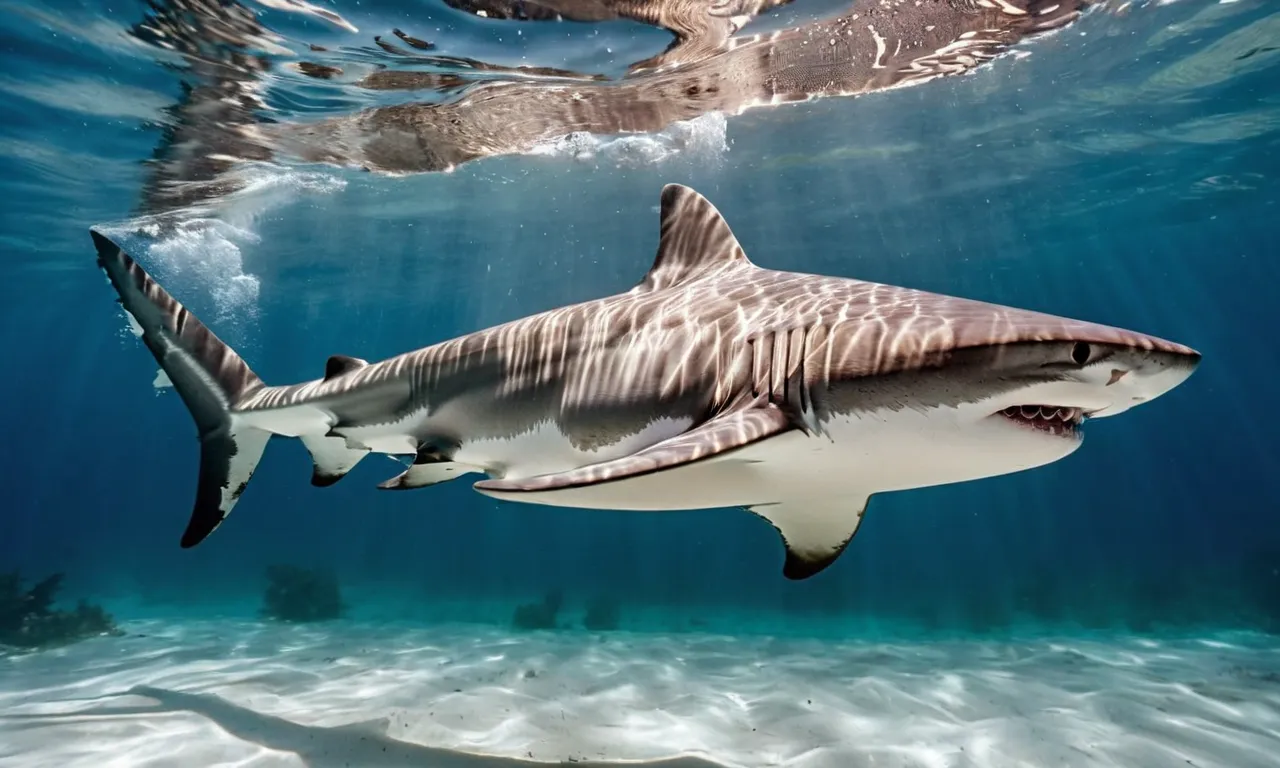When Are Sharks Most Active In Florida?
The waters off Florida’s coastline are home to over 40 species of sharks, from nurse sharks to tiger sharks. If you plan to hit the beaches or take a dip while visiting the Sunshine State, you may be wondering when it’s peak season for shark activity.
If you’re pressed for time, here’s the quick answer: Shark activity peaks in Florida during the summer months of June through August when water temperatures are warmest and tourist numbers are highest. Bull, blacktip, spinner, and hammerhead sharks are especially abundant and active now.
In this comprehensive guide, we’ll break down exactly when different shark species are most frequently spotted off Florida’s shores. We’ll explore how water temperature, migrations, breeding cycles, and fishing seasons impact shark activity monthly and by region of the state.
Shark Activity by Month
January
In January, shark activity in Florida tends to be relatively low. This is because the water temperature is cooler, and many shark species prefer warmer waters. However, it’s important to note that sharks are still present in Florida’s waters year-round, so it’s always a good idea to exercise caution when swimming or participating in water activities.
February
In February, shark activity starts to increase slightly as the water temperature begins to rise. While the number of shark encounters may still be relatively low, it’s always wise to be aware of your surroundings and follow any local beach safety guidelines.
March
March marks the beginning of spring in Florida, and with it comes an increase in shark activity. As the water temperature continues to warm up, more sharks may be seen in coastal areas. It’s important to remember that most shark encounters are rare and can usually be avoided by practicing safe swimming habits and staying informed about any recent shark sightings in your area.
April
April is a month when shark activity in Florida typically picks up. With the arrival of spring break and more people heading to the beaches, there is an increased likelihood of encountering sharks. However, it’s important to note that the risk of a shark attack is still extremely low, and fatal encounters are even rarer.
By following beach safety guidelines and staying informed, you can enjoy the water while minimizing any potential risks.
May
May is another month when shark activity in Florida tends to be higher. As the weather gets warmer and more people flock to the beaches, the chances of encountering sharks may increase. However, it’s important to remember that the vast majority of shark species are not aggressive towards humans and are more interested in their natural prey.
By being mindful of your surroundings and following any safety recommendations from lifeguards or local authorities, you can enjoy the beautiful Florida waters with peace of mind.
June
June is peak beach season in Florida, and this means an increase in shark activity. With warmer waters and more people in the ocean, it’s important to remain vigilant and take necessary precautions. Remember to swim in groups, avoid swimming at dusk or dawn, and stay away from areas where fishing activity is taking place.
By being aware of your surroundings and practicing responsible beach behavior, you can minimize any potential risks associated with sharks.
July
July is another month when shark activity is typically high in Florida. With the summer heat and school holidays in full swing, more people are flocking to the beaches, and this can attract sharks as well.
It’s important to remember that shark encounters are still relatively rare, and fatal incidents are even rarer. By following beach safety guidelines, such as swimming in groups and avoiding areas with a lot of baitfish activity, you can enjoy the ocean while minimizing any potential risks.
August
In August, shark activity remains high in Florida’s waters. With the peak of summer and warm waters, more people are enjoying the ocean, which can lead to an increase in shark encounters. However, it’s important to remember that the risk of a shark attack is still extremely low.
By staying informed about any recent shark sightings, swimming in designated areas, and avoiding swimming at dawn or dusk, you can enjoy the beautiful Florida beaches safely.
September
September marks the end of the summer season in Florida, and with it comes a slight decrease in shark activity. As the water temperature begins to cool down, some shark species may start to migrate to different areas.
However, it’s important to remember that sharks are still present in Florida’s waters year-round, so it’s always a good idea to stay informed and follow any beach safety guidelines.
October
In October, shark activity in Florida may still be relatively high. While the water temperature is cooling down, there are still plenty of sharks present in the coastal areas. It’s important to exercise caution when swimming or participating in water activities and to be aware of any recent shark sightings or beach safety warnings in your area.
November
November marks the start of the cooler season in Florida, and with it comes a decrease in shark activity. As the water temperature continues to cool down, some shark species may start to migrate to warmer waters.
However, it’s important to note that sharks are still present in Florida’s waters year-round, so it’s always a good idea to stay informed and practice safe swimming habits.
December
In December, shark activity in Florida tends to be relatively low. The water temperature is cooler, and many shark species prefer warmer waters. However, it’s important to remember that sharks are still present in Florida’s waters year-round, so it’s always a good idea to exercise caution and follow any local beach safety guidelines.
Peak Regions and Hotspots for Shark Activity
Florida is known for its stunning beaches and warm waters, but it also attracts a wide variety of marine life, including sharks. If you’re curious about when sharks are most active in Florida, it’s essential to understand the peak regions and hotspots for shark activity.
These areas offer prime conditions for sharks to thrive and can provide thrilling opportunities for shark enthusiasts and researchers alike.
The Florida Panhandle
The Florida Panhandle, with its pristine white sandy beaches and crystal-clear waters, is one of the prime regions for shark activity in Florida. From Pensacola to Panama City, this stretch of coastline is home to a diverse range of shark species.
Bull sharks, blacktip sharks, and spinner sharks are commonly found in these waters, particularly during the warmer months. If you’re looking for an adrenaline rush, this region is a must-visit for shark enthusiasts.
North Atlantic Coast
The North Atlantic Coast of Florida, which includes popular destinations such as Jacksonville and Daytona Beach, is another hotspot for shark activity. The warm waters of the Gulf Stream attract numerous shark species, including tiger sharks and hammerhead sharks.
It’s not uncommon to spot these majestic creatures close to the shore, particularly during the spring and summer months. However, it’s important to remember that while shark sightings are relatively common, shark attacks are extremely rare.
Central East Coast
The Central East Coast of Florida, encompassing areas like Cocoa Beach and Melbourne, is renowned for its consistent surf and excellent fishing opportunities. It’s also a region frequented by sharks, especially during the migration seasons.
From February to April, blacktip sharks migrate along this coastline, often seen jumping out of the water. This annual spectacle attracts both locals and tourists, who gather to witness this incredible display of nature.
South Atlantic Coast
The South Atlantic Coast of Florida, including Miami and Fort Lauderdale, boasts a vibrant marine ecosystem that is teeming with sharks. This region offers a chance to encounter various shark species, such as lemon sharks, nurse sharks, and reef sharks.
The warm and clear waters create an ideal habitat for these magnificent creatures. Snorkeling or diving in this area can provide an up-close and personal experience with these fascinating predators.
Florida Keys
The Florida Keys, a string of tropical islands stretching from Key Largo to Key West, is a haven for shark enthusiasts. This area is known for its incredible diversity of marine life, including a multitude of shark species.
From encounters with nurse sharks in the shallow waters to thrilling encounters with bull sharks and reef sharks in deeper waters, the Florida Keys offer unforgettable experiences for those seeking shark encounters.
Remember, sharks play a vital role in maintaining a healthy marine ecosystem. While it’s important to be cautious and respect their presence, it’s equally important to appreciate the beauty and significance of these magnificent creatures.
If you’re planning a trip to Florida and hoping to catch a glimpse of these fascinating animals, be sure to visit one of the peak regions or hotspots mentioned above. Just remember to keep your eyes peeled and enjoy the wonders of Florida’s shark-filled waters!
Why Shark Activity Fluctuates
Shark activity in Florida can vary throughout the year due to several factors. Understanding these fluctuations can help both locals and tourists make informed decisions about when and where to enjoy Florida’s beautiful beaches.
Water Temperature and Migrations
One of the key factors influencing shark activity is water temperature. Sharks are ectothermic creatures, meaning their body temperature is regulated by the surrounding water. As water temperatures rise, sharks become more active and migrate to areas where the water is warmer.
Conversely, when the water cools down, sharks may move to deeper waters or migrate to find more suitable temperatures. For example, during the summer months when the water is warm, shark activity tends to be higher in Florida.
According to research conducted by the Florida Fish and Wildlife Conservation Commission (FWC), the most commonly encountered sharks in Florida are the blacktip shark, spinner shark, and lemon shark. These species are known to migrate along the Florida coast, following warmer water temperatures and the availability of prey.
So, if you’re planning a beach trip during the summer months, it’s important to be aware of the increased likelihood of encountering these sharks.
Breeding Cycles
Another factor that affects shark activity is their breeding cycles. Just like many other marine creatures, sharks have specific times of the year when they mate and give birth to their young. During these periods, sharks may exhibit more aggressive behavior as they focus on reproducing and protecting their offspring.
For example, the bull shark, which is known for its aggressive nature, typically mates and gives birth in the warm coastal waters of Florida. This means that during certain months, when bull sharks are actively breeding, their presence near the shore may be more prevalent.
It’s important for beachgoers to be cautious and follow any local guidelines or warnings during these times.
Fishing Seasons
Fishing activity can also impact shark behavior and their proximity to the shore. Florida is a popular destination for recreational fishing, and some species of sharks are targeted by anglers. When fishing seasons are open for certain shark species, it can attract more sharks to the areas where fishing is taking place.
According to the FWC, the most common sharks caught by recreational anglers in Florida are blacktip sharks, hammerhead sharks, and nurse sharks. These species are known for their size and strength, making them popular targets for sport fishing.
Therefore, it’s not uncommon to see an increase in shark activity near areas where fishing is prevalent.
Conclusion
While shark activity occurs year-round off Florida due to the state’s warm climate, late spring through summer is undoubtedly peak season. By understanding monthly and regional patterns, you can enjoy Florida’s beautiful beaches and waters more safely.
Heed warning signs, swim in groups, and avoid excess splashing to minimize risk.
Florida’s shark biodiversity makes it a top spot for shark enthusiasts. With proper precautions, we can coexist responsibly and preserve these amazing creatures for future generations.








